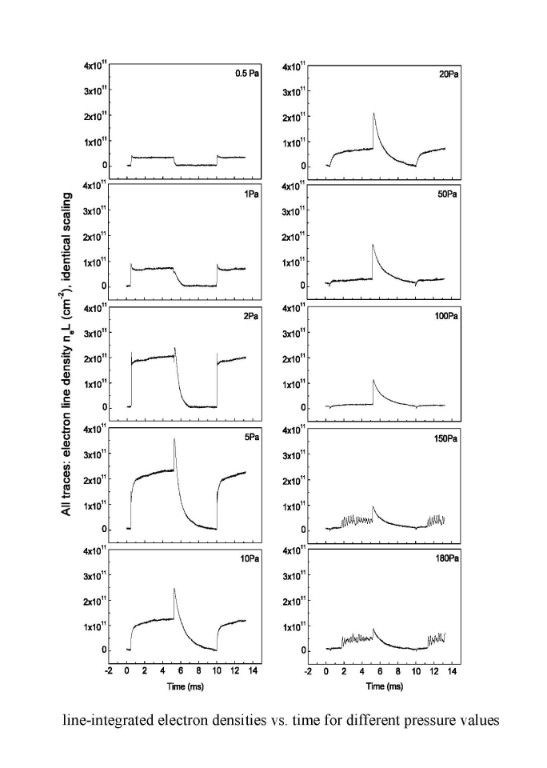APPLICATION NOTE
Plasma density is a key parameter to understanding, modeling and control of plasma processes. In plasma installations for basic research and in industrial plasma reactors, it can depend not only on usually controlled parameters as RF power, gas composition and gas pressure but also on parameters which are not easy to determine: discharging mode, presence of impurities, walls condition, etc. For instance: alpha-gamma transition in the capacitively coupled discharge between substantially different discharge modes is accompanied by considerable growing of plasma density; variation of density in a plasma reactor with time can give evidence of chamber contamination; substantial decrease of electron density in reactive plasma can be resulted from formation of dust particles in plasma which are able to collect electrons. Plasma density measurements thus is not only needed for basic research but can also be useful for developing of technological processes and control of them for achieving of reproducible results.
Microwave interferometry uses microwave radiation for investigation of plasma dielectric properties. They are related directly to plasma electron density which can be in the general case determined from phase shift and attenuation of the microwaves in plasma. Although the density obtained is averaged over a line between transmitting and receiving antennas, this diagnostics has a number of advantages in comparison with Langmuir probe which is traditionally used in the low temperature plasma:
- it is applicable in reactive depositing plasmas where Langmuir probe measurements are strongly affected by contamination of the probe surface and practically unusable.
- it is not invasive, i.e. does not disturb and contaminate plasma.
- interpretation of measurements is simpler as compared to the probe, where assumption about ion composition and plasma sheath are needed.
- it is not affected by RF and does not need any RF compensation.
- it has better time resolution and provides more reliable measurements in the afterglow since the quantity under measure does not depend on the temperature.
These features define possible application of the microwave interferometer:
- in reactive plasma, which is used for etching and deposition as well as in the dusty plasma where Langmuir probe measurements is not possible. In comparison with some other diagnostic for reactive plasmas like cavity resonator and resonant probe, the microwave interferometer is not invasive, has much better time resolution and is easy in application.
- in capacitively coupled plasma with high level of RF power where even RF-compensated Langmuir probe faces significant problems.
- in plasma devices without a port for the probe but transparent for microwaves, such as reactors with dielectric chamber and with plasma in glass tubes, including UV and fluorescent lamps.
- in UHV plasmas where even small level of contamination coming from the probe inserted into plasma is unwanted.
- in plasma research where high time resolution is needed.
As an example of microwave interferometer application, we describe briefly an experiment where an remarkable effect of plasma density growing in the afterglow has been observed [A. Brockhaus, G. F. Leu, V. Selenin, Kh. Tarnev and J. Engemann ''Electron release in the afterglow of a pulsed inductively-coupled radiofrequency oxygen plasma'', Plasma Sources Sci. Technol. 15 (2006), 171-177].
The experiment was carried out in an inductively coupled RF discharge in oxygen in wide range of gas pressure. Results of measurements performed by microwave interferometer are shown on Fig. 1. The RF discharge power producing the plasma was pulsed: the RF is turned on at 0 ms and is off at 5ms till the beginning of the next pulse at 10 ms.
A notable feature is a sharp growing of the density just after switching-off the RF power. This afterglow peak of density can be explained by formation of large number of negative ions during RF phase of the discharge and they destruction with release of electrons due to collisions of the negative ions with oxygen atoms and metastable molecules in the afterglow.
The ratio between peak density in afterglow and density during RF thus can give information about the electronegativity grade of the plasma. In the presented experiments, this ratio was growing with pressure so that plasma was appeared to be nearly completely electronegative at pressure higher as 50 Pa.
 |
Fig. 1 |